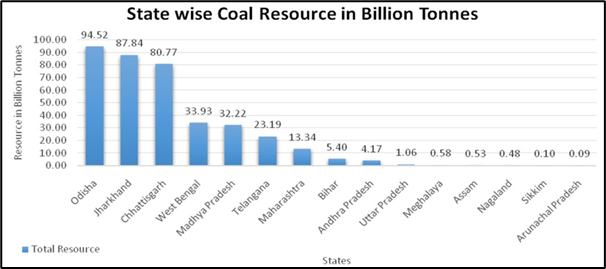Context:
A recent study by iForest (International Forum for Environment, Sustainability and Technology) reveals that India will need over $1 trillion (Rs 84 lakh crore) over the next 30 years for a just transition away from coal. The study, the first of its kind, estimates the costs of phasing down coal mines and plants while ensuring socio-economic stability in coal-dependent regions.
What’s in today’s article?
- Coal Resource in India
- Ensuring a Just Energy Transition in India
- International Support for Coal Phase-Down – Case Studies
- Findings from the Study of Coal-Dependent Districts in India
Coal Resource in India
- Statistics
- According to the National Coal Inventory of 2023, the total estimated coal reserve (resource) of India is 378. 21 billion tonnes as of 01.04.2023.

- Coal Production
- The all India Production of coal during 2023-24 was 997. 83 MT with a positive growth of 11.71%.
- Coal Import
- As per the present Import policy, coal can be freely imported (under Open General Licence) by the consumers themselves considering their needs based on their commercial consideration.
- Coking Coal is being imported by Steel sector mainly to bridge the gap between the requirement and indigenous availability and to improve the quality.
- Other sectors like Power sector, cement etc. and coal traders are importing non-coking coal.
- Total coal import during 2023-24 was 261 million tonnes.
Ensuring a Just Energy Transition in India
- About Just Energy Transition and challenges associated
- A "just" energy transition refers to an equitable and inclusive shift towards a low-carbon economy that takes into account the needs of workers and communities dependent on fossil fuels.
- As the world's second-largest coal producer, India employs a vast number of individuals in coal mining, thermal power plants, logistics, and related sectors.
- Public sector coal companies alone employ over 3.6 lakh workers, with many more in the private sector.
- As India aims for net-zero emissions by 2070, growing its renewable energy capacity will be crucial.
- However, ensuring that coal-dependent workers and regions are not left behind in this transition poses a major financial challenge.
- Balancing economic stability with climate goals will require significant investment.
- Costs associated with a just transition
- A study on India's just transition from coal, based on assessments of coal-dependent districts and international examples from South Africa, Germany, and Poland, identified eight key cost components.
- These include:
- mine closures and site repurposing,
- retiring coal plants and converting them to clean energy,
- skilling workers for green jobs,
- fostering new businesses,
- community support,
- green energy investments,
- compensating states for revenue loss, and
- planning costs.
- Nearly 48% of the estimated $1 trillion required over the next 30 years will be needed for green investments to replace coal-based energy infrastructure with cleaner alternatives.
- Source of funds for this transition
- Funding India’s just transition away from coal will require a mix of public and private investments.
- Public funding, through grants and subsidies, will primarily address "non-energy" costs such as community support, skilling coal workers for green jobs, and aiding new businesses.
- India’s $4 billion District Mineral Foundation funds, collected from miners, along with Corporate Social Responsibility (CSR) funds, can be used to support new businesses and coal-dependent communities.
- Private investments, on the other hand, are expected to cover most of the "energy costs," focusing on developing clean energy projects and green infrastructure.
International Support for Coal Phase-Down – Case Studies
- South Africa’s Just Energy Transition
- South Africa’s Just Energy Transition Investment Plan (JET-IP) will receive international financial support from countries such as the UK, France, Germany, the US, the EU, the Netherlands, and Denmark.
- The plan requires $98 billion over two decades, with $8.5 billion to be provided between 2023-2027.
- Most of the funds will go towards green energy investments, with financing through concessional loans, grants, and public-private partnerships.
- Germany’s Legislative Action on Coal Phase-Out
- Germany has enacted legislation to phase out coal power by 2038, with over $55 billion allocated to close coal mines and power plants.
- The funds will also be used to support coal-dependent regions by fostering economic development.
Findings from the Study of Coal-Dependent Districts in India
- The study focused on four coal-dependent districts: Korba (Chhattisgarh), Bokaro and Ramgarh (Jharkhand), and Angul (Odisha), to assess their reliance on coal and estimate the costs of a just transition.
- In Bokaro, coal-based industries contribute 54% of the district's domestic product, employing around 1,39,000 workers in coal mining, power plants, and related sectors like steel and cement.
- The study estimates that a full coal phase-down in Bokaro will begin after 2040 and will require Rs 1.01 lakh crore over 30 years to rehabilitate workers, repurpose coal sites, and develop green energy infrastructure.










